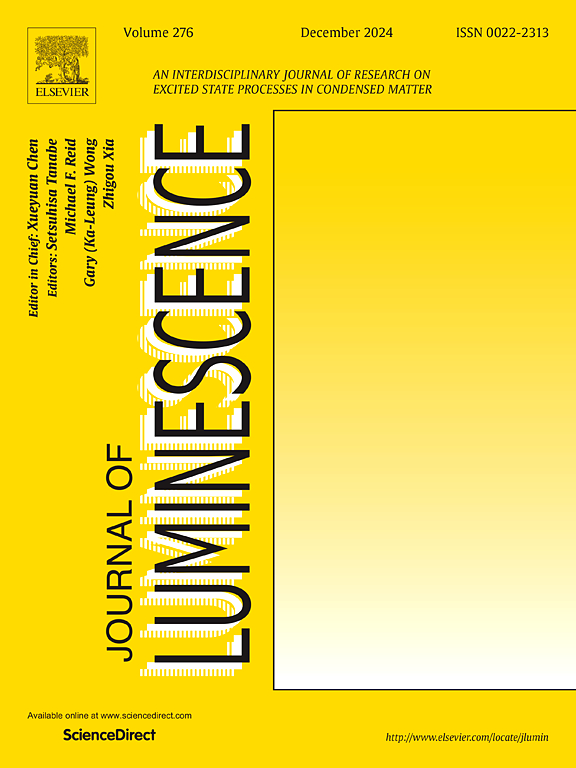Room temperature rubidium–doping strategies for high–luminance perovskite quantum dot light emitting diodes
IF 3.6
3区 物理与天体物理
Q2 OPTICS
引用次数: 0
Abstract
Perovskite quantum dots (PQDs) are renowned for their exceptional optoelectronic properties, yet their practical application is severely hindered by rapid degradation under humid and thermal conditions. In this study, we address this critical issue through a room-temperature Rb+ ion lattice doping strategy, which synergistically optimizes the performance of CsPbBr3 QDs via defect passivation and carrier dynamics modulation. Our experimental results demonstrate that Rb + doping not only tailors the bandgap of CsPbBr3 QDs to the range of 2.40–2.44 eV through band engineering but also significantly enhances the photoluminescence quantum yield from 77.18 % to 90.31 %. Moreover, it dramatically improves the environmental tolerance and thermal stability of the QDs. Kinetic analysis reveals that the exciton recombination lifetime in the modified PQDs is extended threefold to 17.27 ns (3.4 -fold longer than that of pristine PQDs), confirming a substantial reduction in defect density. Based on the Rb + doped CsPbBr3 QDs, we constructed green perovskite quantum dot light-emitting diodes (PQLEDs) that exhibit breakthrough performance, achieving a maximum luminance of 82,740 cd m−2, which is among the highest reported values for A-site-doped systems. The external quantum efficiency (EQE) and current efficiency of these PQLEDs are 7.7 % and 26.28 cd A−1, respectively, which are 1.9 times and 1.7 times higher than those of the control group. This work establishes a novel doping engineering paradigm that effectively overcomes the stability barriers in perovskite optoelectronics.

高亮度钙钛矿量子点发光二极管的室温铷掺杂策略
钙钛矿量子点(PQDs)以其卓越的光电性能而闻名,但其在潮湿和热条件下的快速降解严重阻碍了其实际应用。在本研究中,我们通过室温Rb+离子晶格掺杂策略解决了这一关键问题,该策略通过缺陷钝化和载流子动力学调制协同优化了CsPbBr3量子点的性能。实验结果表明,Rb +的掺杂不仅通过能带工程将CsPbBr3量子点的带隙调整到2.40 ~ 2.44 eV范围内,而且显著提高了CsPbBr3量子点的光致发光量子产率,从77.18%提高到90.31%。此外,它还显著提高了量子点的环境耐受性和热稳定性。动力学分析表明,修饰PQDs中的激子重组寿命延长了3倍,达到17.27 ns(比原始PQDs长3.4倍),证实了缺陷密度的大幅降低。基于Rb +掺杂的CsPbBr3量子点,我们构建了具有突破性性能的绿色钙钛矿量子点发光二极管(pqled),其最大亮度达到82,740 cd m−2,这是a位掺杂系统中报道的最高亮度之一。pqled的外量子效率(EQE)为7.7%,电流效率为26.28 cd A−1,分别是对照组的1.9倍和1.7倍。这项工作建立了一种新的掺杂工程范式,有效地克服了钙钛矿光电子学中的稳定性障碍。
本文章由计算机程序翻译,如有差异,请以英文原文为准。
求助全文
约1分钟内获得全文
求助全文
来源期刊

Journal of Luminescence
物理-光学
CiteScore
6.70
自引率
13.90%
发文量
850
审稿时长
3.8 months
期刊介绍:
The purpose of the Journal of Luminescence is to provide a means of communication between scientists in different disciplines who share a common interest in the electronic excited states of molecular, ionic and covalent systems, whether crystalline, amorphous, or liquid.
We invite original papers and reviews on such subjects as: exciton and polariton dynamics, dynamics of localized excited states, energy and charge transport in ordered and disordered systems, radiative and non-radiative recombination, relaxation processes, vibronic interactions in electronic excited states, photochemistry in condensed systems, excited state resonance, double resonance, spin dynamics, selective excitation spectroscopy, hole burning, coherent processes in excited states, (e.g. coherent optical transients, photon echoes, transient gratings), multiphoton processes, optical bistability, photochromism, and new techniques for the study of excited states. This list is not intended to be exhaustive. Papers in the traditional areas of optical spectroscopy (absorption, MCD, luminescence, Raman scattering) are welcome. Papers on applications (phosphors, scintillators, electro- and cathodo-luminescence, radiography, bioimaging, solar energy, energy conversion, etc.) are also welcome if they present results of scientific, rather than only technological interest. However, papers containing purely theoretical results, not related to phenomena in the excited states, as well as papers using luminescence spectroscopy to perform routine analytical chemistry or biochemistry procedures, are outside the scope of the journal. Some exceptions will be possible at the discretion of the editors.
 求助内容:
求助内容: 应助结果提醒方式:
应助结果提醒方式:


